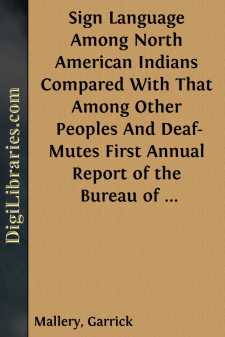Categories
- Antiques & Collectibles 13
- Architecture 36
- Art 48
- Bibles 22
- Biography & Autobiography 813
- Body, Mind & Spirit 142
- Business & Economics 28
- Children's Books 15
- Children's Fiction 12
- Computers 4
- Cooking 94
- Crafts & Hobbies 4
- Drama 346
- Education 46
- Family & Relationships 57
- Fiction 11828
- Games 19
- Gardening 17
- Health & Fitness 34
- History 1377
- House & Home 1
- Humor 147
- Juvenile Fiction 1873
- Juvenile Nonfiction 202
- Language Arts & Disciplines 88
- Law 16
- Literary Collections 686
- Literary Criticism 179
- Mathematics 13
- Medical 41
- Music 40
- Nature 179
- Non-Classifiable 1768
- Performing Arts 7
- Periodicals 1453
- Philosophy 64
- Photography 2
- Poetry 896
- Political Science 203
- Psychology 42
- Reference 154
- Religion 513
- Science 126
- Self-Help 84
- Social Science 81
- Sports & Recreation 34
- Study Aids 3
- Technology & Engineering 59
- Transportation 23
- Travel 463
- True Crime 29
Sign Language Among North American Indians Compared With That Among Other Peoples And Deaf-Mutes First Annual Report of the Bureau of Ethnology to the Secretary of the Smithsonian Institution, 1879-1880, Government Printing Office, Washington,...
by: Garrick Mallery
Categories:
Description:
Excerpt
INTRODUCTORY.
During the past two years the present writer has devoted the intervals between official duties to collecting and collating materials for the study of sign language. As the few publications on the general subject, possessing more than historic interest, are meager in details and vague in expression, original investigation has been necessary. The high development of communication by gesture among the tribes of North America, and its continued extensive use by many of them, naturally directed the first researches to that continent, with the result that a large body of facts procured from collaborators and by personal examination has now been gathered and classified. A correspondence has also been established with many persons in other parts of the world whose character and situation rendered it probable that they would contribute valuable information. The success of that correspondence has been as great as could have been expected, considering that most of the persons addressed were at distant points sometimes not easily accessible by mail. As the collection of facts is still successfully proceeding, not only with reference to foreign peoples and to deaf-mutes everywhere, but also among some American tribes not yet thoroughly examined in this respect, no exposition of the subject pretending to be complete can yet be made. In complying, therefore, with the request to prepare the present paper, it is necessary to explain to correspondents and collaborators whom it may reach, that this is not the comprehensive publication by the Bureau of Ethnology for which their assistance has been solicited. With this explanation some of those who have already forwarded contributions will not be surprised at their omission, and others will not desist from the work in which they are still kindly engaged, under the impression that its results will not be received in time to meet with welcome and credit. On the contrary, the urgent appeal for aid before addressed to officers of the Army and Navy of this and other nations, to missionaries, travelers, teachers of deaf-mutes, and philologists generally, is now with equal urgency repeated. It is, indeed, hoped that the continued presentation of the subject to persons either having opportunity for observation or the power to favor with suggestions may, by awakening some additional interest in it, secure new collaboration from localities still unrepresented.
It will be readily understood by other readers that, as the limits assigned to this paper permit the insertion of but a small part of the material already collected and of the notes of study made upon that accumulation, it can only show the general scope of the work undertaken, and not its accomplishment. Such extracts from the collection have been selected as were regarded as most illustrative, and they are preceded by a discussion perhaps sufficient to be suggestive, though by no means exhaustive, and designed to be for popular, rather than for scientific use. In short, the direction to submit a progress-report and not a monograph has been complied with....


